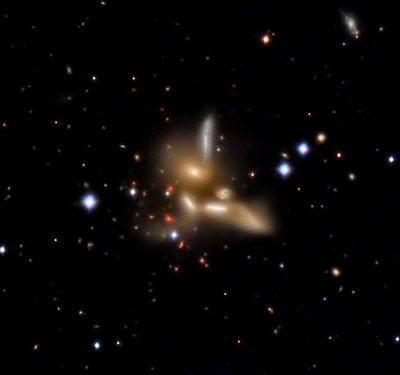by KuriousGeorge » Wed May 23, 2018 4:32 am
Seyfert's Sextet from KG Observatory, Julian, CA.
This object was a challenge at only 2' x 2' and between magnitude 15 and 16.
Seyfert's Sextet is a group of galaxies about 190 million light-years away in the constellation Serpens. The group appears to contain six members, but one of the galaxies is a background object and another "galaxy" is actually a separated part of one of the other galaxies. The gravitational interaction among these galaxies should continue for hundreds of millions of years. Ultimately, the galaxies will merge to form a single giant elliptical galaxy.
The small S-shaped galaxy, NGC 6027d, is not interacting with the other galaxies in the cluster, but is in the background and just happens to be in the same line of sight. The galaxy is nearly 900 million light years from Earth and is believed to be extremely large in size at magnitude 16.47.
Imaging telescope or lens:Planewave CDK24
Imaging camera:FLI Proline 16803
Mount:Planewave L600
Guiding camera:Starlight Xpress Ultrastar
Focal reducer:None
Software:Planewave PWI4, Planewave PWI3, PixInsight 1.8, Maxim DL6, PHD Guiding 2, Neat Image V7, Photoshop CS3, Sequence Generator Pro
Filters:Astrodon 50mm R, Astrodon 50mm B, Astrodon 50 mm G, Astrodon 50mm L
Accessories:FLI CFW-5-7, Astrodon Monster MOAG, Hedrick Focuser, Planewave Delta-T, Planewave EFA
Resolution: 1486x1392
Dates: May 15, 2018, May 17, 2018
Frames:
Astrodon 50 mm G: 12x300" -20C bin 1x1
Astrodon 50mm B: 8x300" -20C bin 1x1
Astrodon 50mm L: 24x300" -20C bin 1x1
Astrodon 50mm R: 12x300" -20C bin 1x1
Integration: 4.7 hours
Darks: ~20
Flats: ~80
Flat darks: ~80
Bias: ~20
Avg. Moon age: 1.12 days
Avg. Moon phase: 2.81%
Mean SQM: 21.60
Astrometry.net job: 2071130
Locations: KG Observatory, Julian, CA, United States
Data source: Backyard
- Attachments
-

Seyfert's Sextet from KG Observatory, Julian, CA.
This object was a challenge at only 2' x 2' and between magnitude 15 and 16.
Seyfert's Sextet is a group of galaxies about 190 million light-years away in the constellation Serpens. The group appears to contain six members, but one of the galaxies is a background object and another "galaxy" is actually a separated part of one of the other galaxies. The gravitational interaction among these galaxies should continue for hundreds of millions of years. Ultimately, the galaxies will merge to form a single giant elliptical galaxy.
The small S-shaped galaxy, NGC 6027d, is not interacting with the other galaxies in the cluster, but is in the background and just happens to be in the same line of sight. The galaxy is nearly 900 million light years from Earth and is believed to be extremely large in size at magnitude 16.47.
Imaging telescope or lens:Planewave CDK24
Imaging camera:FLI Proline 16803
Mount:Planewave L600
Guiding camera:Starlight Xpress Ultrastar
Focal reducer:None
Software:Planewave PWI4, Planewave PWI3, PixInsight 1.8, Maxim DL6, PHD Guiding 2, Neat Image V7, Photoshop CS3, Sequence Generator Pro
Filters:Astrodon 50mm R, Astrodon 50mm B, Astrodon 50 mm G, Astrodon 50mm L
Accessories:FLI CFW-5-7, Astrodon Monster MOAG, Hedrick Focuser, Planewave Delta-T, Planewave EFA
Resolution: 1486x1392
Dates: May 15, 2018, May 17, 2018
Frames:
Astrodon 50 mm G: 12x300" -20C bin 1x1
Astrodon 50mm B: 8x300" -20C bin 1x1
Astrodon 50mm L: 24x300" -20C bin 1x1
Astrodon 50mm R: 12x300" -20C bin 1x1
Integration: 4.7 hours
Darks: ~20
Flats: ~80
Flat darks: ~80
Bias: ~20
Avg. Moon age: 1.12 days
Avg. Moon phase: 2.81%
Mean SQM: 21.60
Astrometry.net job: 2071130
Locations: KG Observatory, Julian, CA, United States
Data source: Backyard